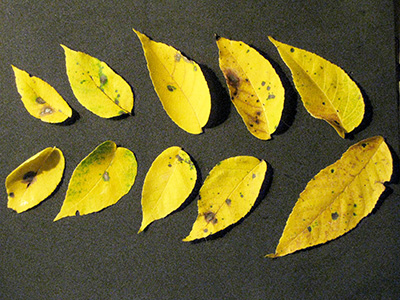Walnut anthracnose is putting an early end to many leaves
Yellow, spotted leaves are falling from walnut trees due to the annual visit of this fungal disease known as walnut anthracnose.

Anyone that has a black walnut tree, Juglans nigra, in their yard knows that this is a native tree with a short growing season. Leaves appear later than many other trees in the spring. In the late summer or early fall, yellowed leaves begin raining down before most of the other trees begin dropping leaves. One of the most notable contributors to the early leaf loss is a fungal disease called walnut anthracnose.
Walnut anthracnose only affects walnuts and butternuts which belong to the same genus of Juglans. There are other forms of anthracnose though. In the spring, other kinds can infect maples, oaks and other shade trees. There are forms of anthracnose that can cause problems with tomatoes, beans, cucumbers and squash during the growing season for these plants. Each growing year, Michigan State University Extension horticulture educators and Master Gardener hotlines receive calls about one form of anthracnose or another. It is a fungus whose very existence is tied to temperature and humidity. Mild temperatures and high humidity or rain are the magic weather events to kick anthracnose into gear. The tender growth of new leaves is the target.
The first symptom that is seen on black walnut leaves is small, round, brown spots that are seen initially on the bottom of leaves. In wet seasons, those early spots develop in late July or August. Soon, the spots are on both the bottom and top of leaves. Some are as small as pinheads while others are much larger. The leaf then turns a brilliant yellow. There may be brown edges appearing on leaves and leaves begin to drop. Anthracnose may also cause problems with the leaf petioles, twigs and walnut fruit. The stem or rachis that runs between the nine pairs of leaflets could also be marked.
 Fruit could fall prematurely or nuts might have dark, shriveled nut meats, but in most cases, the only symptom is lemon yellow, lightly freckled leaves floating downward. After a hard rain or strong winds, tree owners could be shocked at the number of yellow leaves littering the lawn. A quick look at fallen leaves with the scattered spots gives a quick explanation for the event.
Fruit could fall prematurely or nuts might have dark, shriveled nut meats, but in most cases, the only symptom is lemon yellow, lightly freckled leaves floating downward. After a hard rain or strong winds, tree owners could be shocked at the number of yellow leaves littering the lawn. A quick look at fallen leaves with the scattered spots gives a quick explanation for the event.
It is not necessary to control walnut anthracnose in almost all situations. If the tree is experiencing multiple years of early almost complete defoliation, it is weakening the tree. Control for walnut anthracnose can be accomplished by two actions. The disease spends the winter in fallen leaves, fruit and twigs. In the fall, rake up, remove and destroy as much of this material as possible. In the spring, an application of a straight nitrogen fertilizer encourages more leaf growth and reduces disease severity. This is a fertilizer like 46-0-0 (urea) or 21-0-0 (ammonium sulfate) applied at or below bag recommendations. Fertilizers that also contain phosphorus or potassium are not as effective as the straight nitrogen fertilizers. Read and follow the application rates on the bag and do not exceed the recommended amount per 1,000 square feet. Too much nitrogen can damage or kill the tree you are trying to protect.



 Print
Print Email
Email




